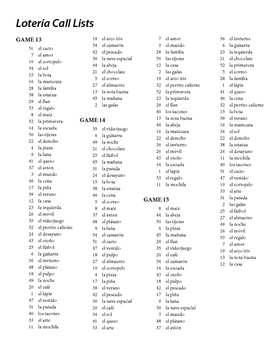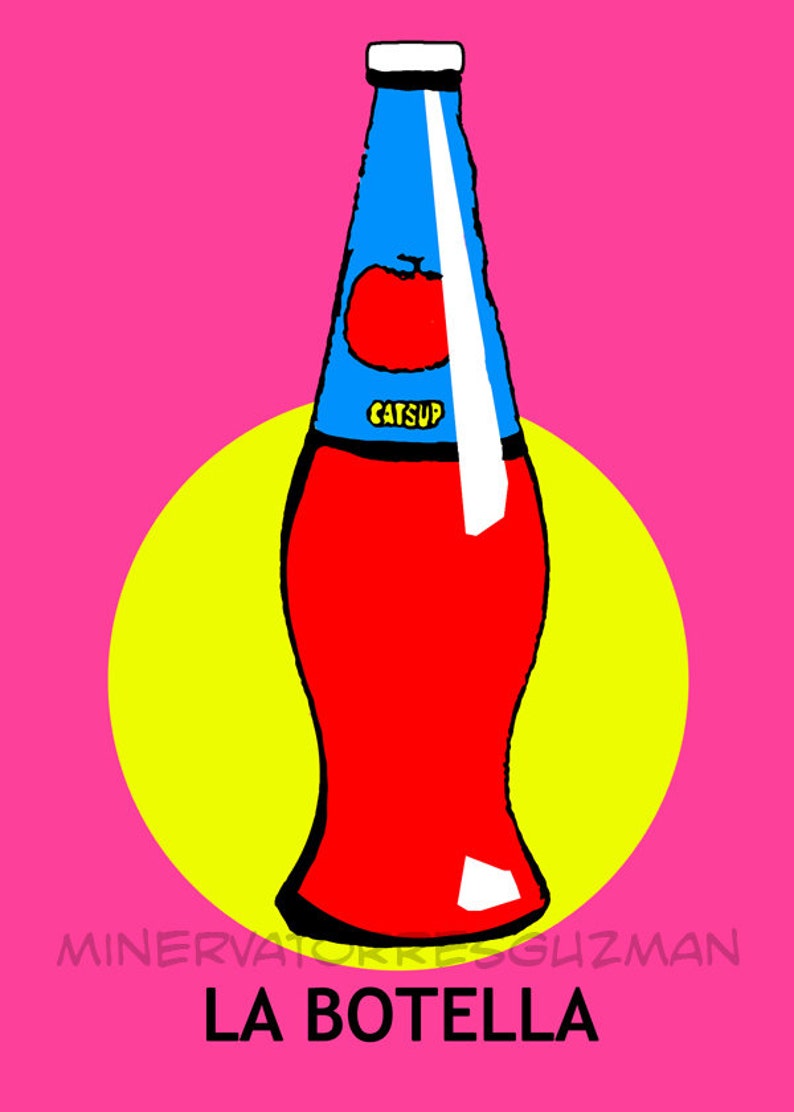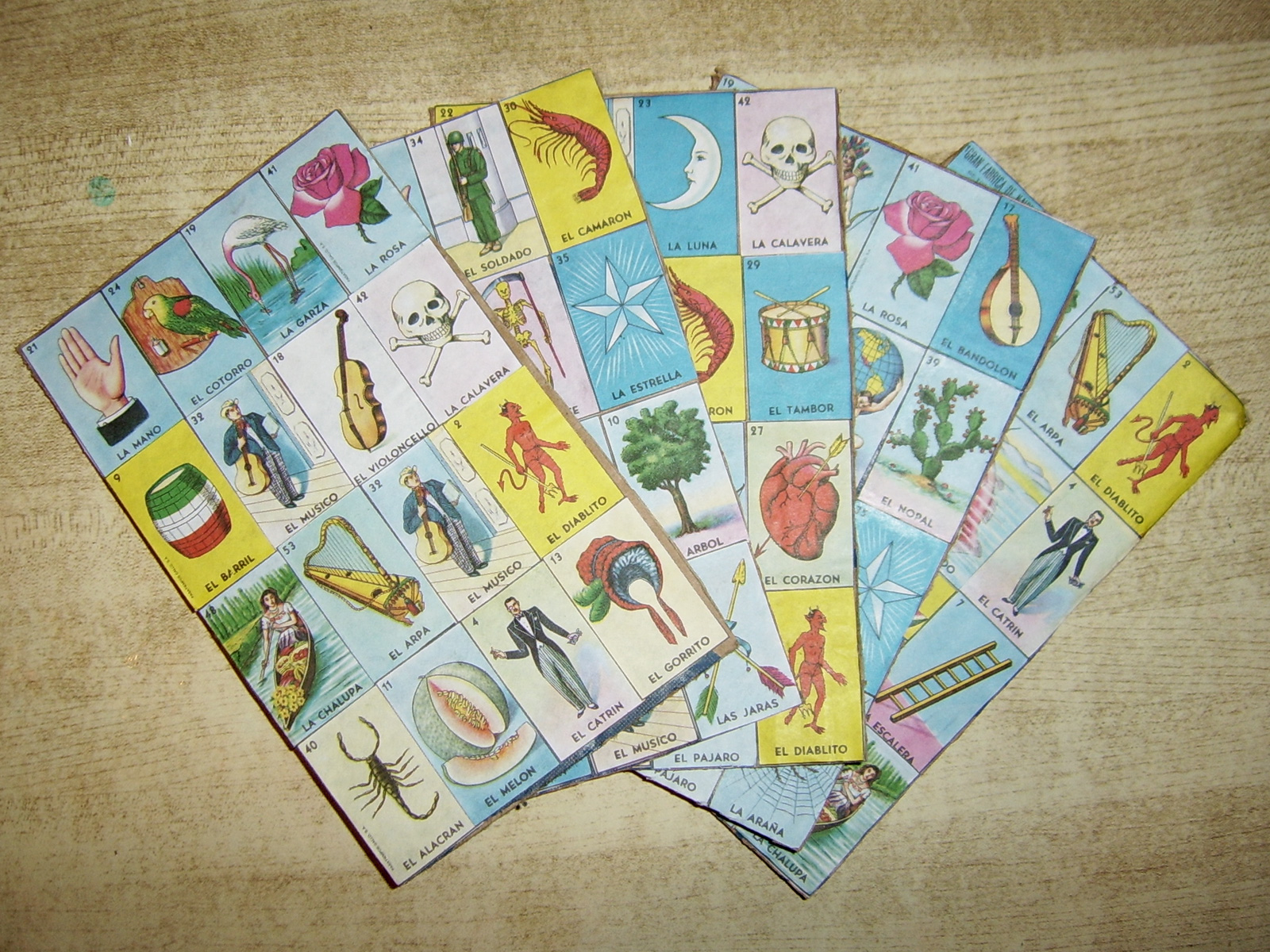Mexican Loteria Cards List
Great deals on Loteria Cards. Expand your options of fun home activities with the largest online selection at eBay.com. Fast & Free shipping on many items! LOTERIA MEXICAN BINGO CARD SPANISH LOTTERY GAME SET 10 BOARDS 54 CARDS BRAND NEW. La Mexicana Loteria Giant (Mexican Bingo) 9' X 14' $10.50. For a long time, my favorite was La Sirena, but as time has passed, I’ve come to appreciate the value of just about each and every card. In any case, here’s our list of the top cards. La Sirena – People love La Sirena, and I’m pretty sure it’s not just because she’s topless.
- How To Make Mexican Loteria Cards
- Mexican Loteria Cards To Print
- Mexican Loteria Cards List 2020
- All Loteria Cards
| Other name(s) | Mexican bingo[1] |
|---|---|
| Language(s) | Spanish |
| Random chance | High |
| Material(s) required | cards |
Lotería is a traditional game of chance, similar to bingo, but using images on a deck of cards instead of numbered ping pong balls. Every image has a name and an assigned number, but the number is usually ignored. Each player has at least one tabla, a board with a randomly created 4 x 4 grid of pictures with their corresponding name and number. Players choose a tabla to play with, from a variety of previously created tablas, each with a different selection of images.
Lotería is the Spanish word for lottery. The deck is composed with a set of 54 different cards with a picture on it. To start, the caller (cantor, or singer) shuffles the deck. One by one, the caller picks a card from the deck and announces it to the players by its name, sometimes using a verse before reading the card name. Each player locates the matching pictogram of the card just announced on their board and marks it off with a chip or other kind of marker. In Mexico, it is traditional to use small rocks, crown corks or pinto beans as markers. The winner is the first player that shouts '¡Buena!' right after completing a tabla or a previous agreed pattern: row, column, diagonal or a pozo.
Lotería de Pozo is a variant version of the traditional Mexican Lotería, where the basic rules apply. For this version, before the game begins, players agree on how many pozos are to be completed in a row, column or diagonal pattern. A Pozo is a group of images in a square. The square may contain 2 x 2 (4) or 3 x 3 (9) images[2] for a traditional tabla.
Loteria online game[3] is a game to allow computer users to play an online a version of the Lotería Mexicana. It was created in 1996.[3]
History[edit]
How To Make Mexican Loteria Cards
The origin of lotería can be traced far back in history. The game originated in Italy in the 15th century and was brought to New Spain (modern Mexico) in 1769. In the beginning, lotería was a hobby of the upper classes,[1] but eventually it became a tradition at Mexican fairs.
Don Clemente Jacques began publishing the game in 1887.[1] The current images have become iconic in Mexican culture, as well as gaining popularity in the US and some European countries. Other popular Lotería sets are Lotería Leo, Gacela and Lotería de mi tierra.
During the 1930s, the Catholic church came up with their own version of la Lotería. It consisted of Catholic images instead of the traditional images used in the original game. The Catholic church did this to promote their beliefs by making their very own game board similar to the Lotería.[1]
Cards and associated verses[edit]
Mexican Loteria Cards To Print
The following is a list of the original 54 lotería cards, traditionally and broadly recognized in Mexico. Below each card name and number, are the verses (in Spanish) sometimes used to tell the players which card was drawn. However, there are several less traditional sets of cards, depicting different objects or animals.

1 El gallo ('the rooster')
2 El diablito ('the little Devil')
3 La dama ('the lady')
4 El catrín ('the dandy')
5 El paraguas ('the umbrella')
6 La sirena ('the mermaid')
7 La escalera ('the ladder')
8 La botella ('the bottle')
9 El barril ('the barrel')
10 El árbol ('the tree')
11 El melón ('the melon')
12 El valiente ('the brave man')
13 El gorrito ('the little bonnet')
14 La muerte ('Death')
15 La pera ('the pear')
16 La bandera ('the flag')
17 El bandolón ('the mandolin')
18 El violoncello ('the cello')
19 La garza ('the heron')
20 El pájaro ('the bird')
21 La mano ('the hand')
22 La bota ('the boot')
23 La luna ('the moon')
24 El cotorro ('the parrot')
25 El borracho ('the drunkard')
26 El negrito ('the little black man')
27 El corazón ('the heart')
| 28 La sandía ('the watermelon')
29 El tambor ('the drum')
30 El camarón ('the shrimp')
31 Las jaras ('the arrows')
32 El músico ('the musician')
33 La araña ('the spider')
34 El soldado ('the soldier')
35 La estrella ('the star')
36 El cazo ('the saucepan')
37 El mundo ('the world')
38 El Apache ('the Apache')
39 El nopal ('the prickly pear cactus')
40 El alacrán ('the scorpion')
41 La rosa ('the rose')
42 La calavera ('the skull')
43 La campana ('the bell')
44 El cantarito ('the little water pitcher')
45 El venado ('the deer')
46 El Sol ('the sun')
47 La corona ('the crown')
48 La chalupa ('the canoe')
49 El pino ('the pine tree')
50 El pescado ('the fish')
51 La palma ('the palm tree')
52 La maceta ('the flowerpot')
53 El arpa ('the harp')
54 La rana ('the frog')
|
Google tribute[edit]
On December 9, 2019, Google celebrated Lotería with a Google Doodle.[4] The interactive game has the El Apache, El borracho, El diablito, El gorrito, La muerte, El negrito, El soldado, and El valiente cards replaced with El ajolote ('the axolotl'), El buscador ('the search engine'), La concha ('the conch'), El elote ('the fresh ear of corn'), El emoji ('the emoji'), El gorro ('the cap'), El guacamole ('the guacamole'), and El xoloitzcuintle ('the hairless dog').[citation needed] Artworks for La sirena and El guacamole cards not found during the game can still be seen in the background of the end screen.

References[edit]
- ^ abcdVillegas, Teresa. 'History of La Lotería'Archived 2017-01-16 at the Wayback Machine, www.teresavillegas.com
- ^'Lotería de Pozo'. www.maravillasoftware.com. Archived from the original on 2018-11-17. Retrieved 2018-10-20.
- ^ ab'How the Loteria Mexicana / Mexican Bingo became an online game?'. Maravilla Software. Archived from the original on 2019-06-13. Retrieved 2019-06-21.
- ^'Celebrating Lotería!'. Google. 9 December 2019. Archived from the original on 9 December 2019. Retrieved 9 December 2019.
Further reading[edit]
- Lotería: A Novel, by Mario Alberto Zambrano
- Playing Lotería: El Juego de La Lotería, by René Colato Laínez
- El Arte de la Suerte, by Artes de Mexico Número 13, Otoño 1991, Nueva Época
External links[edit]
- Media related to Lotería (board game) at Wikimedia Commons
- Software to print Lotería: Loteria Workshop
- Lotería de pozo : Another way to play lotería
- Rules and pictures(in Spanish)
Photo showing how Loteria was created by Clemente Jacques, known as the Mexican lottery, became popular culture around 1945-1950. Casasola Archive. Collection: © 172058SC.INAH.FN.
You may be surprised to know that the quintessential Mexican game called La Lotería has its origins in Europe and came to Mexico by way of Spain.
Mexican Loteria Cards List 2020
The traditional Loteria originated in Italy, moved to Spain, and finally came to Mexico in 1769. Initially played by the colonial Mexican elite, it eventually was embraced by all social classes.

In the 19th and early 20th centuries, Mexican farms and towns were few and far between. Traveling Ferias (fairs) would set up in these ranchlands and small towns on the weekends, and many people would go out to them especially to play Loteria.
The game is very similar to American Bingo, with some differences. In Bingo, a number with an associated letter is randomly chosen from a rotating drum, while in Loteria, with a colorfully illustrated image is drawn from a special deck of 54 cards. The modern versions of these cards also contain the name of the image at the bottom and an associated number at the top. In both games, each player has a different game board/tabla. In Bingo, the game board has random numbers listed under their associated letters, while in Loteria, the tabla has a random pattern of images matching those found on the cards.
Tabla de Loteria, watercolor on paper Mexico c.1920 Collection of San Antonio Museum of Art
Many of the older tablas do not have words or numbers, since the originally was found in prose. These tablas were made either out of tin or paper that had been painted by popular artists, some of whom specialized in this art form.
Lotería is often referred to as “Mexican Bingo.” For anyone who has had the opportunity to play Lotería, will find similarities in playing American Bingo. However, players will quickly realize, how much more visually and intellectually engaging and fun it is to play Lotería than the American Bingo game. In American Bingo, an announcer calls out the selected letters and numbers, such as “B-4” and the players mark their game boards accordingly.
In Lotería, the announcer gives an improvised short poem or familiar phrase alluding to the image on the card (e.g. “The coat for the poor” for the image of the sun, or “The one who dies by the mouth” for the image of the fish). Each player uses a chip -often a kernel of corn or a bean-to mark the corresponding spot on his or her tabla. In either game, the first player to appropriately fill the game board or tabla in a predefined pattern will shout either “Bingo!”or “Lotería!” to win the game and receive the prize.
Since poetic license is afforded to the announcer of Lotería, the success and popularity of the announcer depend on his cleverness and style.
All Loteria Cards
El Sol and El Pescado Loteria Cards. Images ©unknown (but I suspect they belong to Don Clemente Gallo)

The announcer’s approach will often depend on the social context in which the game is being played. At a church bazaar, for example, he might use a more tame humor, while for a game played in an adult setting he might use innuendos that are more risqué and derisive. Satire and references to contemporary events and politics are often a part of the word play involved; in fact, the linking of images to social commentary has existed since the inception of the game.
Loteria has been played as a game of chance, as a pastime, and for educational purposes. Because the Loteria cards include the name of the pictured character, they are used to teach reading, writing, history, and social values. Many bilingual teachers use the game as a teaching tool in the United States.
One of the more interesting historical versions was an educational , liturgical Loteria that appeared in the 1930’s. The images employed were objects and concepts found with the Catholic Church. This combination of the irreverence and banality of the game coupled with the solemnity of sacred symbols had some Catholics concerned. While the marriage of church and gambling in the form of Bingo in the United States is common, the initial attempt of the church-sanctioned liturgical loteria was more educational –to allow the parishioners to differentiate between a tunic and a maniple, for example.

Eccleastic Loteria image use by permission from private Collection of Carlos Monsavais
The most recognized version of Loteria is the “Don Clemente Gallo” rendition introduced into Mexico in 1887 by the French businessman, Don Clemente Jacques.
He purchased a manufacturing plant in Mexico to produce many items, including packaged food products, corks and bottles, and ammunition. In their printing press division they produced labels for the packaged foods, advertisements, invitations, party favors, calendars and the game La Loteria.
It was told to me by Gallo that when they packaged the canned food for the military rations they included a little game of Loteria for the soldiers to play to pass the time. When the soldiers would bring home the game to their families it was a big hit and became hugely popular with the general public thus creating a big demand and embraced fully within the Mexican culture.
The owners today of of Don Clemente Gallo Pasatiempos own the registered trademark of the original images, including the most famous and better known images that have existed.
As Mexican culture spread across the border, so did the demand for the game within the United States. The original Don Clemente Gallo Loteria game can be purchased today not only in Mexico but also in the United States, and online all over the internet. Many collectors have been purchasing and sharing them online, perpetuating the love of Loteria and the cultural significance and historical value of this game.
2001 Both Loteria game sets published and produced by Don Clemente Gallo. The Nuevo Loteria game set are images by American artist Teresa Villegas.
Artists have been inspired by the images of Lotería since its inception and is not a unique occurrence. I was one of many artists who were inspired by the imagery of the game, the enthusiasm of the players and by the announcers who were gifted poets and wordsmiths.
While living in Mexico (2000) it was in the research, for my installation paintings that I first interviewed Gallo. Gallo was very generous with giving their time, historical facts and information for the development of this work. While meeting with Gallo, they had asked to see my paintings and so I had shown them a few sample paintings and the sketches for the remaining. They had liked what they saw and asked if they could use my images for publishing and distributing a new version of their game. They were excited at the thought of “sprucing up” the 100-year-old game, and I was excited too and thus the “Nuevo Versión” Lotería game was born.
Gallo produced and distributed it throughout Mexico and the US from 2001-2008. During the initial process of publishing this nuevo Loteria game, Gallo had offered me to have a higher end printing of the game than the original game. However, I wanted to keep with the historical intent when Lotería first came to Mexico for the purpose of soldiers’ passing the time, and to keep it affordable and available “for the masses.” Therefore the printing quality and the retail prices remained the same as the original lotería game. The royalties I received from Gallo, I donated back to Mexico to FAI Save the Children Foundation, Mexico.
In 2008, as did many businesses, Gallo cut back the production of many of their products because of the global economic recession, thus ending the production and distribution of el “Nuevo Verisión de Lotería.” Copyright for these Nuevo Loteria images now remain with me as my contract with Gallo has expired. For any of you who have purchased this version, you now have a “collectors item” and I hope you play it until it falls apart like my family’s has. And because I truly believe that “the experience is better than the artifact.”.